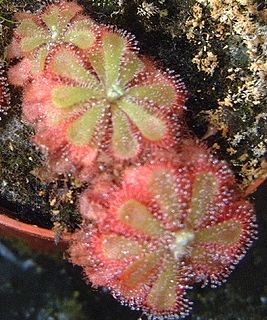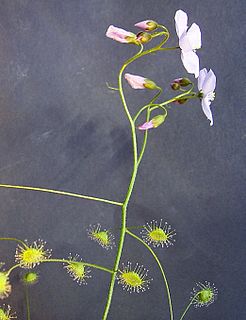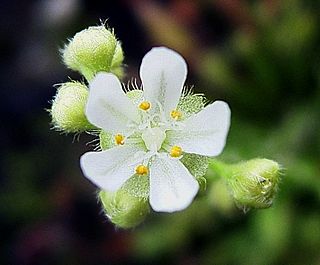
Drosera brevifolia, is a carnivorous plant of the family Droseraceae and is the smallest sundew species native to the United States. This species differs considerably from the pink sundew, Drosera capillaris, by its wedge-shaped leaves, and distinctly deeper red to reddish purple color, noticeable when side by side with D. capillaris.

The Paraíba do Sul, or simply termed Paraíba, is a river in southeast Brazil. It flows 1,137 km (706 mi) west to northeast from its farthest source at the source of the river Paraitinga to the sea near Campos dos Goytacazes. The river receives its name when it meets the river Paraibuna at the Paraibuna dam.

Drosera aliciae, the Alice sundew, is a carnivorous plant in the family Droseraceae. It is native to the Cape Provinces of South Africa, like Drosera capensis, the cape sundew, and is one of the most common sundews in cultivation. The plant forms small, tight rosettes of wedge-shaped leaves, up to 5 cm in diameter. Under conditions of good lighting, the insect-snagging tentacles will become deeply coloured with anthocyanin pigments, which probably aid in its attraction of insect prey. The plant is relatively easy to grow, and produces attractive scapes of pink flowers, which are held about 30 cm away from the carnivorous leaves, so as to prevent pollinators from becoming ensnared. D. aliciae is very similar in form to a number of other closely related species such as D. slackii, and D. dielsiana: the former is rather larger ; the latter rather smaller.

Drosera regia, commonly known as the king sundew, is a carnivorous plant in the sundew genus Drosera that is endemic to a single valley in South Africa. The genus name Drosera comes from the Greek word droseros, meaning "dew-covered". The specific epithet regia is derived from the Latin for "royal", a reference to the "striking appearance" of the species. Individual leaves can reach 70 cm (28 in) in length. It has many unusual relict characteristics not found in most other Drosera species, including woody rhizomes, operculate pollen, and the lack of circinate vernation in scape growth. All of these factors, combined with molecular data from phylogenetic analysis, contribute to the evidence that D. regia possesses some of the most ancient characteristics within the genus. Some of these are shared with the related Venus flytrap (Dionaea muscipula), which suggests a close evolutionary relationship.

The campo rupestre is a discontinuous montane subtropical ecoregion occurring across three different biomes in Brazil: Cerrado, Atlantic Forest and Caatinga. Originally, campo rupestre was used to characterize the montane vegetation of the Espinhaço Range, but recently this term has been broadly applied by the scientific community to define high altitudinal fire-prone areas dominated by grasslands and rocky outcrops.

Drosera indica is an insectivorous plant, a sundew native to tropical countries throughout the world, from Asia to Africa, but absent from the neotropics. Together with Australian endemic species D. aquatica, D. aurantiaca, D. barrettorum, D. cucullata, D. finlaysoniana, D. fragrans, D. glabriscapa, D. hartmeyerorum, D. nana, D. serpens it makes up the section Arachnopus.

Drosera macrantha, the bridal rainbow, is a scrambling or climbing perennial tuberous species in the carnivorous plant genus Drosera that is endemic to Western Australia. It grows in a variety of habitats, including winter-wet depressions in sandy, loamy, laterite, or quartzite soils. D. macrantha produces small, cup-shaped carnivorous leaves along a long stem that can be 0.16–1.5 m (0.5–4.9 ft) high as it climbs. Its 1 in (2.5 cm) white or pink flowers emerge from June to November, blooming earlier in the more northern range.
Drosera moorei is a scrambling or climbing perennial tuberous species in the carnivorous plant genus Drosera. It is endemic to Western Australia and grows near granite outcrops in sandy loam. D. moorei produces small, circular, peltate carnivorous leaves along glabrous stems that can be 12–35 cm (5–14 in) long. Inflorescences have two to ten yellow flowers and bloom from September to October.

Drosera sessilifolia is a species in the carnivorous plant genus Drosera that is native to Brazil, Guyana, and Venezuela and grows in sandy or gravelly soils in seasonal seepages where a thin film of water collects. It produces a rosette of small, wedge-shaped to round carnivorous leaves that are usually yellowish but become redder with age. Inflorescences produce pink-lilac flowers. It has a chromosome number of 2n = 20.

Drosera darwinensis is a perennial carnivorous plant in the genus Drosera that is endemic to the Northern Territory. Its leaves are arranged in a rosette with one rosette emerging from the root stock. It produces pink or white flowers from December to April. Drosera darwinensis grows in clayey sand from Palmerston to Berry Springs south of Darwin and east to Humpty Doo. It was first described by Allen Lowrie in 1996; the type specimen was collected 0.9 km (0.6 mi) south of Temple Avenue in Palmerston on 8 April 1990. The specific epithet darwinensis refers to region where this plant is found in abundance. It is closely related to D. brevicornis, but differs from that species by its shorter inflorescence.

Drosera dilatato-petiolaris is a carnivorous plant in the genus Drosera and is endemic to Australia, being found in both Western Australia and the Northern Territory. Its leaves are arranged in a rosette and commonly produces plantlets, eventually forming large clumps that can be over 1 ft (0.3 m) across. Green petioles emerging from the center of the rosette are typically 3–5 mm wide, but can vary. Red carnivorous leaves at the end of the petioles are small and round, with most resting on the soil surface. Inflorescences are 18 cm (7 in) long with white flowers being produced from April to May. It has a diploid chromosome number of 2n = 12.
Drosera viridis is a semi-erect or rosetted perennial species in the carnivorous plant genus Drosera. It is known only from Brazil, being found in eastern Paraná and São Paulo and central Santa Catarina at elevations from 550–1,100 m (1,800–3,610 ft). It may, however, also be found in adjacent Argentina, Paraguay, and Uruguay. It typically grows in waterlogged habitats among grasses in white-clayey, reddish lateritic, or humus-rich black-brown soils and is sometimes found submerged with only the leaves above water.
Drosera quartzicola is a species in the carnivorous plant genus Drosera and is endemic to the Serra do Cipó in central Minas Gerais state in southeastern Brazil. It is perennial plant that produces leaves, 0.7–4 cm (0.3–1.6 in) long, in a rosette that is sometimes on a short stem about 4 cm (1.6 in) tall. It is found growing in campo rupestre vegetation along with D. tentaculata and D. chrysolepis. It is typically found growing in silica sands surrounded by white quartz gravel, which is the origin of the specific epithet quartzicola. Drosera quartzicola grows in drier habitats than other Drosera species and flowers earlier in the wet season from January to February. It superficially resembles D. schwackei, but it is more closely related to D. camporupestris, D. graminifolia, and D. chrysolepis.
Drosera peruensis is a carnivorous plant of the genus Drosera, commonly known as the Peruvian sundew. This Drosera species was first identified in Peru in 2002 by Tânia Regina dos Santos Silva and Mireya D. Correa following work to update the genus Drosera for the reference text, Flora Neotropica..
Philcoxia minensis is a rare annual herb of the family Plantaginaceae, that is endemic to the Serra do Cabral area of the Brazilian state Minas Gerais. It was discovered April 17, 1981 by David philcox. in the municipality of Joaquim Felício and grew near other plants from the campos rupestres montane savanna. The exact location of collection was unspecified. The species has been shown to produce phosphatases.

Drosera kaieteurensis is a plant from the sundew family (Droseraceae).
Calycolpus australis is a plant species native to the State of Minas Gerais in Brazil. It can be found on poor, rocky soil that supports grasses but few shrubs or trees.

Drosera tentaculata is a carnivorous plant native to Brazil. The species is endemic to the Brazil and occurs in "rupestre" field at the "Cadeia do Espinhaço" Highlands in the Bahia and Minas Gerais.
Genlisea tuberosa is a carnivorous species in the genus Genlisea that is endemic to Brazil and found only in campos rupestres vegetation. Lacking any roots, it has unpigmented bundles of "rootlike" subterranean organs, technically leaves, which attract, trap, and digest protozoans. This species is unique in the genus in its formation of tubers. As of 2014, Genlisea tuberosa has the smallest known genome of any flowering plant, at 61 Mbp, or 61,000,000 base pairs.

Drosera magnifica is a species of sundew endemic to Pico do Padre Ângelo in eastern Minas Gerais in southeastern Brazil, where it grows among sandstone outcrops in herbaceous and shrubby vegetation. It is one of the three largest species of Drosera – the other two being D. regia from South Africa and D. gigantea from Australia – and was discovered in 2015 through images which appeared on the social network Facebook. It is the largest New World sundew, and it is closely related to Drosera graminifolia and Drosera spiralis. According to the IUCN Red List categories and criteria, it is considered Critically Endangered. Brazil is home to some 30 species of Drosera.













